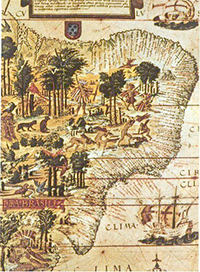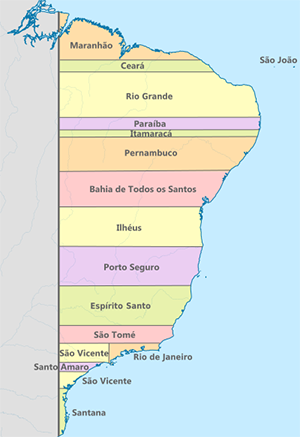Portuguese Rule of Brazil
Part 1: Discovery and Settlement
Martim Afonso de Sousa, another explorer, arrived in 1532 and established São Vicente, the first Portuguese settlement in Brazil. Others followed, all on the eastern coast. Starting in 1534, John III divided the Brazilian colony, the original name of which was Terra de Santa Cruz, into 15 captaincies, each of which was administered by a captain who had considerable powers to rule in the king's stead and profit from the captaincy's intake. The western boundary of the east-west territories was the line drawn by the Treaty of Tordesillas. The 15 captaincies were these:
For a variety of reasons, 11 of the 15 captaincies failed. Four captains never arrived to take possession of their lands, and indigenous peoples also overran four others. The other three failures were due primarily to lack of resources. By 1549, only four captaincies remained: Ilhßus, Pernambuco, Porto Seguro, and São Vicente (combined). The two most successful captaincies were Pernambuco and Sãlo Vicente, the former a prime producer of cotton and sugar cane and home to the thriving city of Olinda and the latter the capital for a long time and a trafficker in both sugar and human slaves. A central government, set up by the first Governor-General, Tomé de Sousa, began in Bahia in 1549. The new capital city of the central government was Salvador da Bahia. A series of governors-general struggled at various times against resistance from indigenous peoples; the colony, overall, prospered. Spain's King Philip II took control of Portugal in 1580 and in 1621 divided the Brazil colony into two states, Brasil and Maranhão. The state capitals were Salvador and São Luís, respectively. After 1640, when Portugal threw off the overlordship of Spain, the leaders of colony were known as Viceroys. Rio de Janeiro, founded in 1565, became the capital in 1763. Twelve years later came the Viceroyalty of Brazil, again with Rio de Janeiro as capital. French sailors had arrived in Brazil in 1502. They later established trade networks, shipping brazilwood back to Europe and battling with Portuguese sailors to protect those trade routes. A French settlement, France Antarctique, came in 1555, in what is now Rio de Janeiro. Portuguese troops under Governor-General Mem de Sá's nephew Estácio, founded the city of Rio and then defeated the French force in 1567, ending French efforts in Brazil. In 1630, Dutch settlers arrived on the northwest coast of Brazil and founded New Holland. As Portugal's colonial presence grew, Dutch and Portuguese forces came into conflict, economic and military. Portugal's final defeat of Dutch forces in Brazil came in 1654. 
It was Tomé de Sousa in 1549 who brought the first group of Jesuits to Brazil. A number of Jesuit priests played a significant role in not only the founding of Rio de Janiero but also in the Portuguese victory over French troops there. It was in the area of conversion to Christianity that the Jesuits their grandest success. The priests went out of their way to learn the language and customs of native peoples and gave them support in exchange for their acceptance of and eventual conversion to the Christian faith. Significantly, the Jesuits spoke out against the enslavement of native peoples; those protests fell largely on deaf ears at the highest levels of government. Next page > Colonization to Independence > Page 1, 2
|
|
Social Studies for Kids
copyright 2002–2025
David White




 The occupation of Brazil by Portugal began, technically, with the arrival of the explorer
The occupation of Brazil by Portugal began, technically, with the arrival of the explorer  Bahia
Bahia
